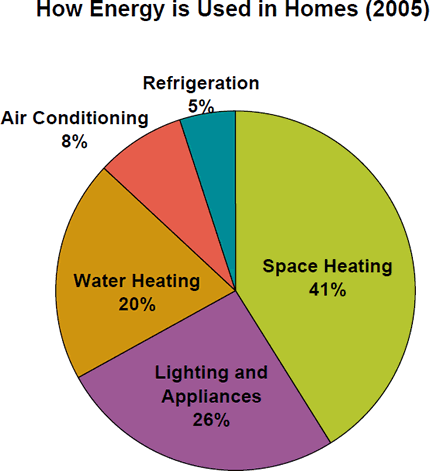A simple search on Google reveals that there are many definitions for the term "energy efficiency." To us, this term means that we will use less energy to achieve the same function at the same level of performance. This page will document the ways in which we are attempting to bring energy efficiency to our home.
The US Department of Energy provides the following breakdown of residential energy use (source):

In Wisconsin, our numbers are a bit different, mainly due to climate. An annual breakdown of energy costs in Wisconsin (source) finds the following:
| Energy Use | % of total cost |
| Heating and cooling | 52% |
| Water heating | 23% |
| Appliances | 13% |
| Lighting | 7% |
| Other | 5% |
Heating and Cooling
With heating and cooling accounting for more than half of the annual average energy cost, it is no surprise that many of the "Wisconsin Energy Star Homes" requirements are measures to make a space heating system more efficient.
Wisconsin is a heating-dominated climate, with an average of 7000-8000 heating degree days and 500-800 cooling degree days per year. (source)
In our home, we seek to reduce our energy consumption related to space heating:
- Geothermal is one of the most efficient heating and air conditioning technologies available today.
- Insulation and air sealing - reducing the heat loss and gain will reduce the workload on the heating and air conditioning systems.
- Energy efficient windows - the Pella designer series features triple-pane glass and are Energy Star qualified with a low U value (0.29). Additionally the windows have an air leakage rating less than 0.06 cfm/ft and solar heat gain coefficients well below 0.40.
- Design - the nearly square shaped house with the minimum possible attic/roof area for the square feet will reduce heat loss through the attic and walls, simply because there is less surface area for heat to escape.
- The furnace is centrally located to minimize the length of duct runs, and is equipped with an electronically commutated motor (variable speed). It also has two stages of heating and cooling, so it can run in a partial mode when full heating/cooling is not required. (Thus far, the system has not gotten out of first stage.)
- Ceiling fans will be installed for comfort, allowing a higher temperature setting during cooling season.
- Whole house dehumidifer - particularly useful during the cooling season, when ventilation with outside air at night can reduce the air conditioning used, while still maintaining healthy and comfortable humidity levels.
- Heat Recovery Ventilator - providing ventilation while recovering heat during the winter and cooled air during the summer.
Water Heating
In Wisconsin, 23% of our energy costs go down the drain... literally. The heat put into the water for showers, laundry, and dishwashing is lost when you're done with that water. In addition to lifestyle choices and practical methods, for example only running the dishwasher when it is full, we are incorporating the following technologies into the home for further savings:
- High efficiency water heater - Our hot water heater is Energy Star qualified with an energy factor of .64, which qualifies us for the Focus on Energy rebate.
- Installation of a drain water heat recovery unit.
- Our showerheads are "low flow" -- when less water is used during the shower, less water needs to be heated.
- Only one showerhead per shower is installed, again because less water used in the shower is less water to heat.
- The "desuperheater" of the geothermal system provides hot water generation. In the summer, heat removed from the house that would normally be placed into the ground is instead placed into the domestic hot water system, resulting in "free" hot water.
- The hot water heater has factory-installed heat traps, to prevent hot water from flowing out of the tank by convection.
- Our dishwasher and clothes washer have built-in water temperature boost features.
- We have insulated hot water pipes throughout most of the basement.
Appliances
- Our dishwasher, refrigerator, and clothes washer are Energy Star qualified.
- Energy can be saved while cooking by using the microwave, toaster oven, rotisserie, or roaster rather than the full-size oven when possible.
- We will have a gas cooktop rather than an electric one. When you turn on a gas stove, you instantly get a flame, whereas electric stoves often take longer to heat and cool. In addition the cooktop features electric ignition, cutting gas use by 40% versus a stove with a pilot light (source).
- Our clothes washer spins out excess moisture, reducing the workload for the clothes dryer.
- Our clothes dryer and bath fans will be vented directly to the outside with smooth, short runs.
Lighting
In our previous house, we replaced most incandescent bulbs with compact fluorescent bulbs and in the year following, our consumption of electricity was down about 10%. In this new house, we are taking several measures to reduce energy use for lighting:
- The vast majority of our lighting fixtures are Energy Star qualified (51 of 55 fixtures). These come with fluorescent, compact fluorescent, or LED bulbs. This qualifies the house for the Energy Star Advanced Lighting Package and we get 12 x $15 rebates through Focus on Energy for Energy Star fixtures.
- Our kitchen and dining room recessed lights use LED lighting. A total of 11 LED fixtures qualify for 11 x $30 rebates through Focus on Energy.
- Where incandescent bulbs are used (fan light kits mainly), dimmer switches are being installed.
- All outdoor lighting is equipped with a photocell. That way, if we forget to turn lights off, they will not remain on throughout the day when they serve no purpose but to waste energy.
- Our ceiling fans are also Energy Star qualified.

